You may not find this terribly rewarding unless you're included here, so this is a good time for casual and random browsers to turn back before they get too caught up in the sweep and majesty of the proceedings and can't let go.
We've been having touristy fun in San Leo, but we've saved enough time to come back to San Marino to revisit the landmarks without the pestilential rain, 17 December 2017.
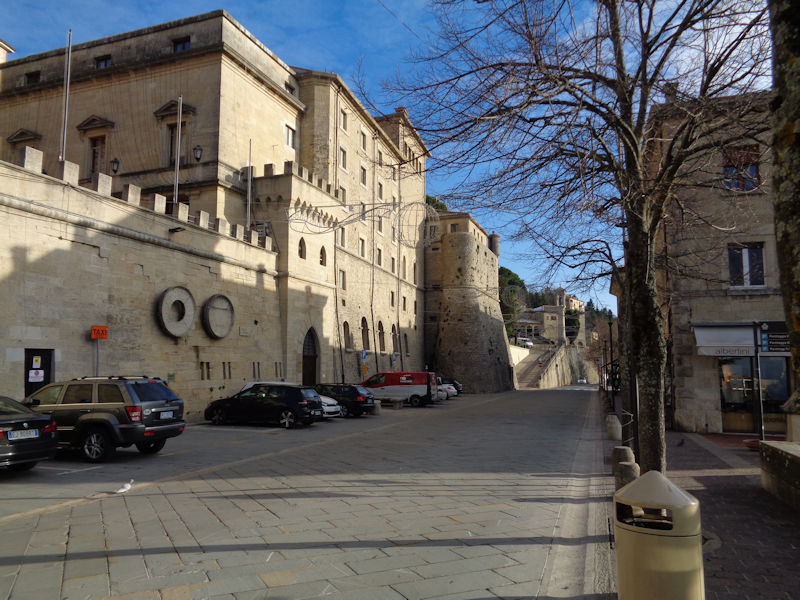
Up the various levels of elevators to the serious city gate on this side of town . . .

. . . the San Francesco Gate.
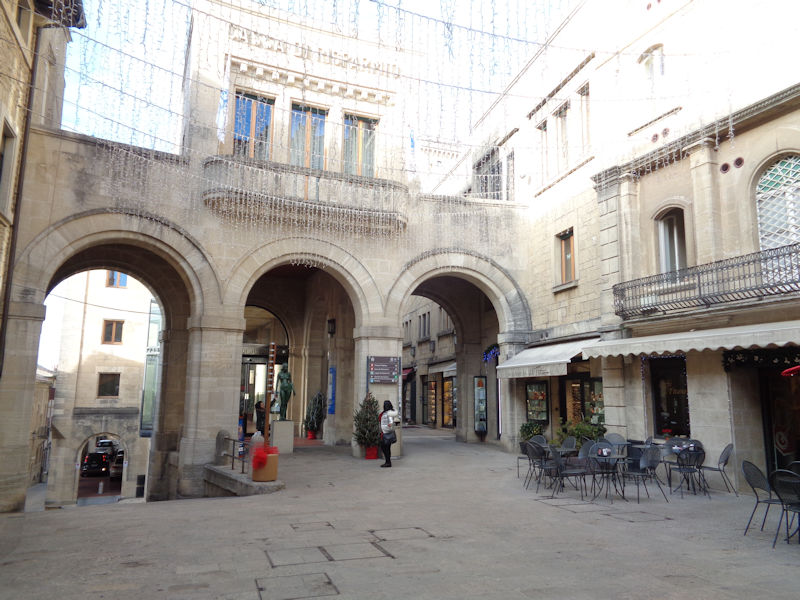
Up the first level to the Piazzetta del Titano (named for the mountain we're on), with the Museo del Stato out of sight on the left; now turning back up to the right . . .
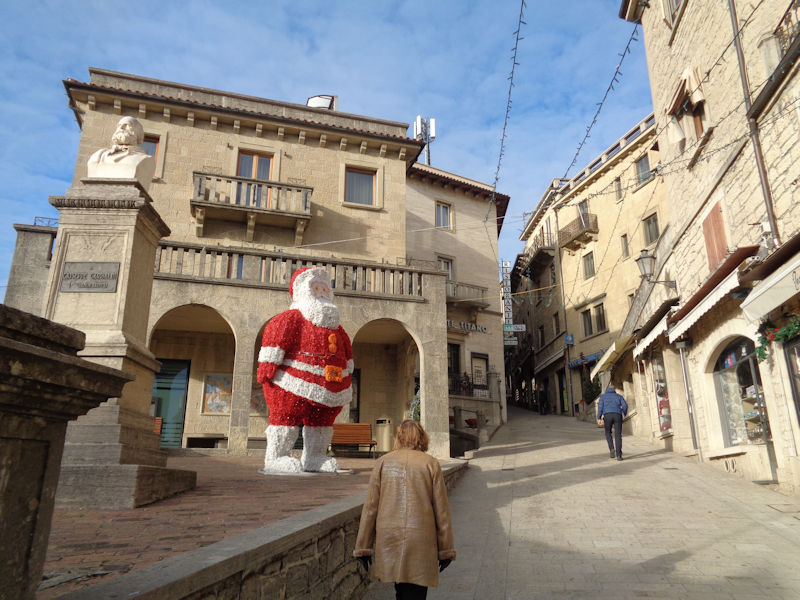
. . . to the Piazza Garibaldi, with tributes to Garibaldi and Santa Claus

Up to the next level, the Piazza della Libertà and . . .
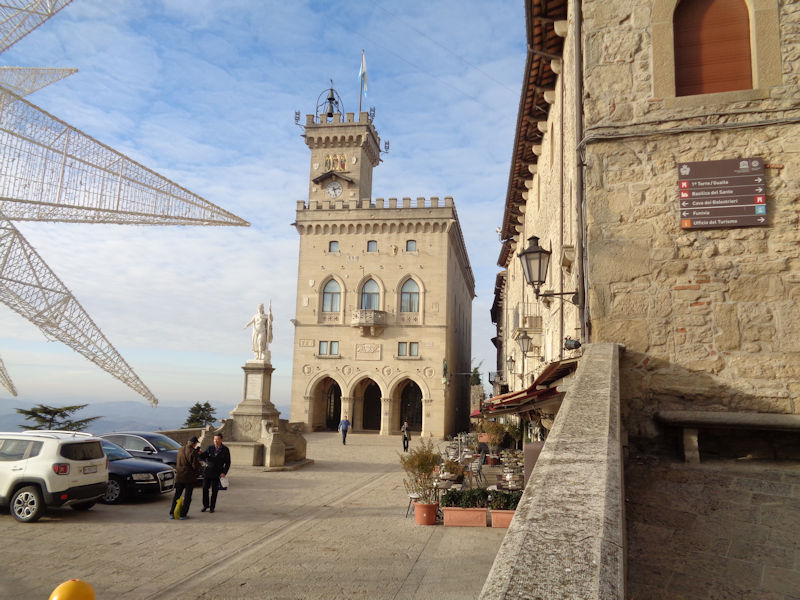
the Palazzo Pubblico

And onward to the next level, with the Basilico del Santo di San Marino, completed in 1838
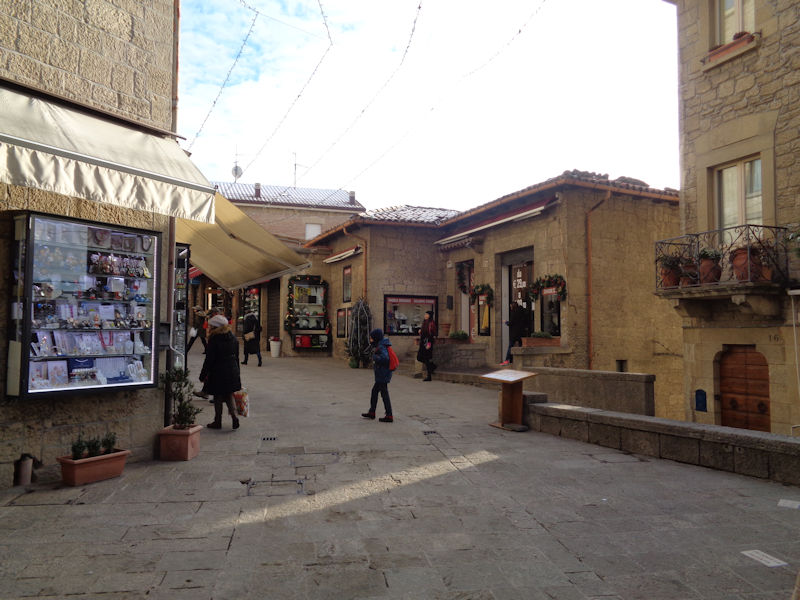
The Salita Alla Rocca, just below the 'First Tower', the Torre or Castello della Guaita

Up to the Castello della Guaita (photo taken a few days ago in the rain). The Guaita Tower, so named from one of the three peaks on Monte Titano, dated originally from the 11th century, but was extensively improved in the 15th century in response to depredations by the Malatesta lords of nearby Rimini. In 1463, Federico da Montefeltro, lord of Urbino, from the family of life-long enemies of the Malatestas in this region but working for Pope Pius II at the time, came to the aid of the Republic in throwing Sigismondo Pandolfo Malatesta's forces out.
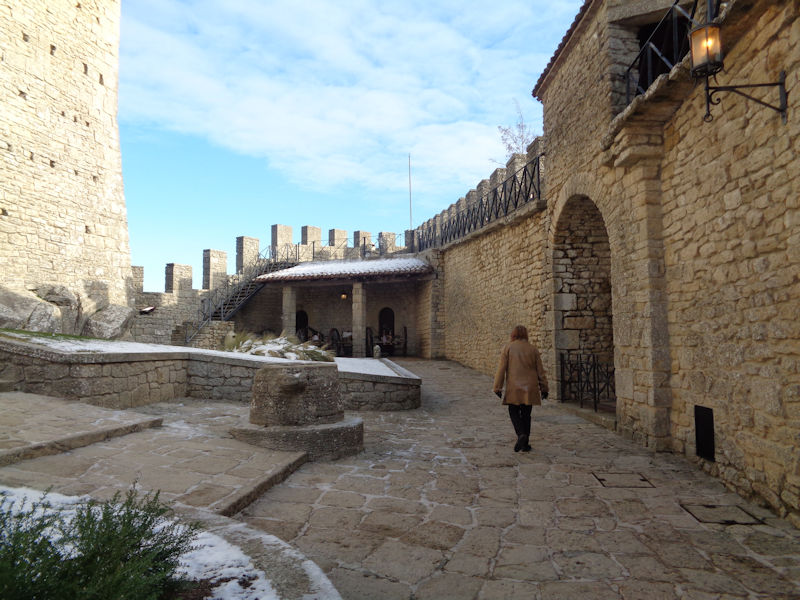
Grateful for San Marino's support in his campaigns against Sigismondo Malatesta, in 1463 Pius II gifted the Republic with some castles and the towns of Fiorentino, Montegiardino and Serravalle from Rimini's lands surrounding Monte Titano, creating the extent of San Marino today.
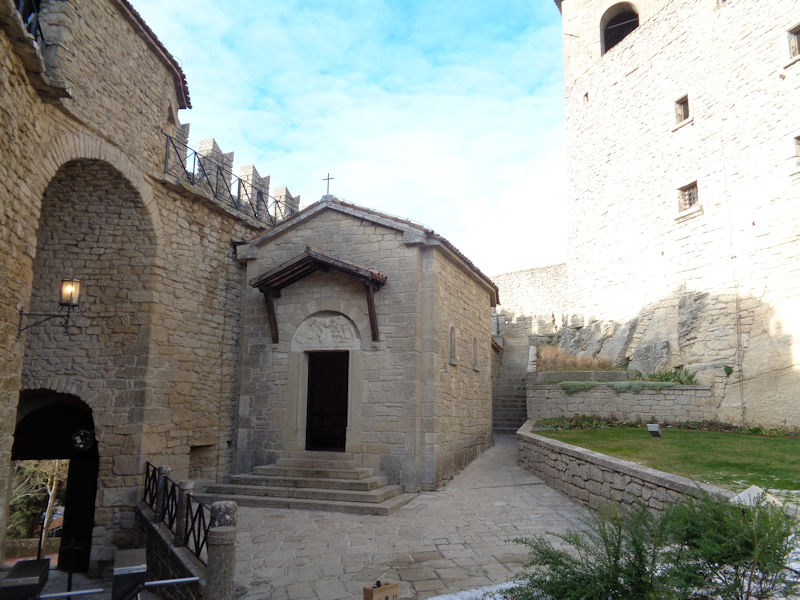
A more recent chapel just inside the front gate
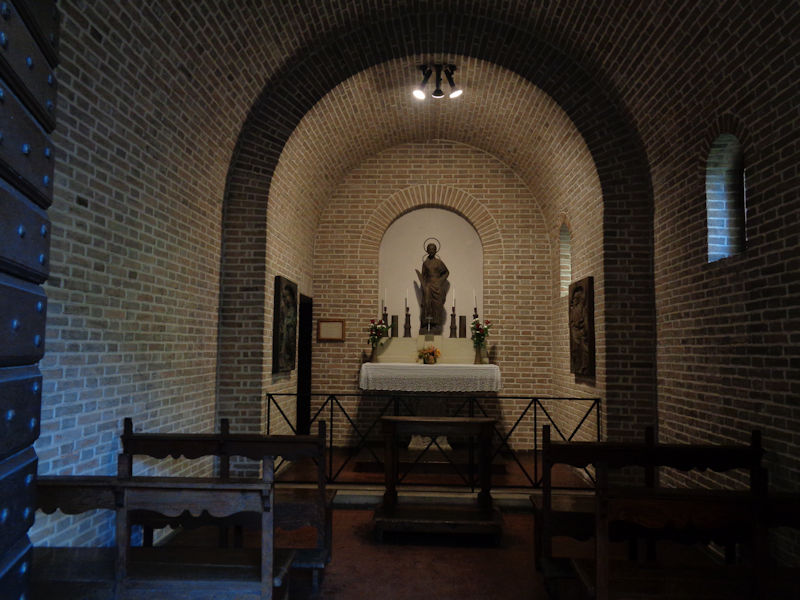
Cute. Functional.
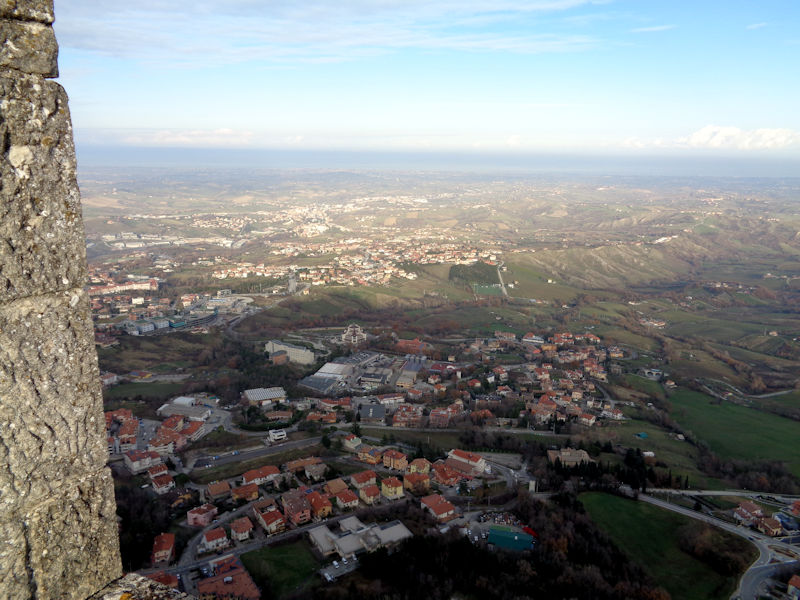
A look from the battlements to the northeast, towards Rimini and the sea

A look more towards the east, towards the San Marinese castello of Faetano. Montegiardino would be farther off the right.

The 'Second Tower', the Torre Cesta, on Monte Titano's slightly higher peak (ca. 750m), about 350m farther along the ridge

The tower keep. The first documentary mention of the Guaita Tower, probably a watchtower rather than a fortress, dates from 1253, but in 1371 there was mention of the 'three mighty fortresses' of San Marino.

But the main work of building the outer walls and the tower dates from the 15th century, a time of great aggressive military turbulence in the Romagna and Marche regions.

The design and structure of the Guaita tower were not well suited to 16th century artillery warfare, whether incoming or outgoing fire, and by 1550 the castle was already beginning to be put to use as a prison; in 1563 one of the prisoners set the tower roof on fire. Although many medieval-era urban castles still retained important civic administrative and mob control functions, a large proportion of the surviving ones saw service as prisons.

The doorway into the keep

Major restorations of the Torre Guaita took place in 1933-1935, and in 1942 the tower was raised to its original height. According to information in the castle, the prison function was transferred in 1959 to the Convent of the Capuchins (though Wikipedia says that it had been used as a prison up to 1975).

The view to the north: the Palazzo Pubblico and the Basilica di San Marino in the background, and in the centre middleground, the Museo delle Creature della Notte - Vampiri e Licantropi (by all accounts, quite shocking and fully appreciated by horror movie fans on holiday).

The Torre Cesta

We're up on the little parade ground in the keep; the belltower was added in about 1530, they tell us.

The tower itself -- the interior is open to the public, but today the staircase is icy, and 'the better part of valor' seemed the preferred way to go.

Directly below the Guaita Tower, this is the high point of the main city wall and the gatehouse leading out to the ridgeline leading to the Second Tower, the Cesta.

The Torre Cesta, Tower No. 2, along the Passo delle Streghe, or Witches' Walk, from the Guaita gatehouse in the city wall

Below the city wall from the Witches' Walk, this is the ancient quarry for castle-building, now a carpark normally but at the moment a seasonal ice-skating rink with Santa Claus attractions.

The Castello della Guaita from the Witches' Walk

And in the other direction, the Torre Cesta

The Torre Cesta dates mainly from the 13th century but was built over the foundations of an ancient Roman fortress. In the 16th century an extension of the city walls were brought out here to enclose this fort as well.

A battlement just outside the walls of the Cesta Tower -- the path leads on another 300m to the third tower, called Montale, from the 14th century. It also had a defensive purpose, probably as a watchtower, and was later used as a prison, but it appears that its role in the city's defenses is not well understood. It stood abandoned for centuries until restoration in 1935, and is not open to the public.

Through the gatehouse (and past the ticket booth)(waving my San Marino all-museum pass) . . .

. . . past the chapel

The Cesta Tower houses the Museo delle Armi Antiche, a large collection that looked very interesting but I was a bit up to here with medieval weapons at the moment and I sped through it. There is a Museo delle Armi Moderne back down by the Basilica. The San Marino heraldic crest of the three towers can be seen on the wall.

As enjoyable as the main rooms of the castle were, with the weapons museum, etc., they wouldn't allow me out onto the external walks to the higher tower because of the icy conditions. Even when I offered to sign a liability waiver. So, another of life's disappointments there.

The Guaita Tower from the Cesta Tower

Down the 16th century city wall extension that incorporates the Cesta Tower into the complex -- now lined with souvenir shops, leather goods stores, a few burger and pizza restaurants, all waiting for summer and the return of the holiday hordes.

Cesta Tower from slightly down the walkway inside the walls

The Rimini-Cattolica coastline with beach infrastructure

The Guaita Tower and the quarry again

The Cava Antica quarry

Back to the main city wall at the Porta della Fratta into the Contrada Santa Croce
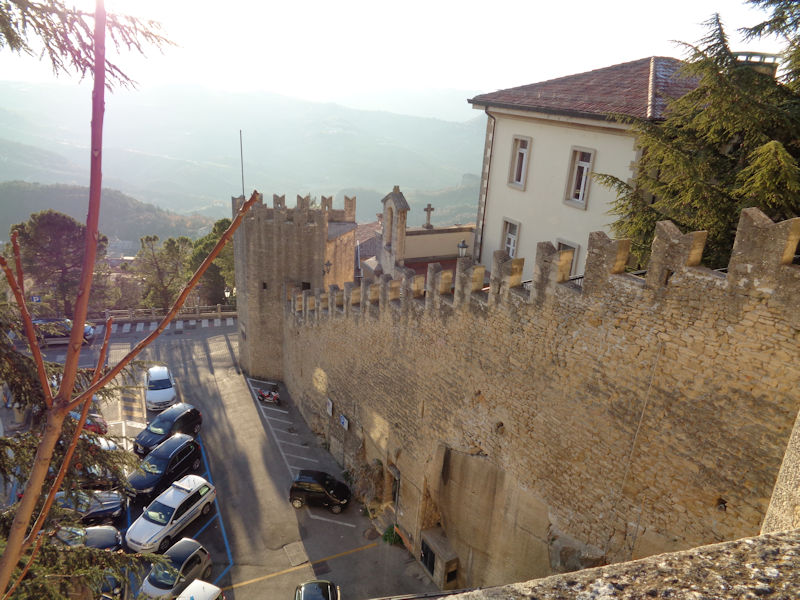
The Piazza Fabbri carpark and gatehouse leading to the Via Donna Felicissima into the city centre

The Contrada Santa Croce on the left and the Salita all Rocca on the right

Down the wall walk . . .

. . . to the Via Donna Felicissima

Back into the city centre

Just doors down from the Piazza Garibaldi, there's a rather unsettling shop filled with military style weapons, suitable for use in any US school, church, or mall.

When the AR-15s are selling for €34, you're prompted to look more closely. Evidently they're all replicas and compressed air pellet guns. Unpleasant enough, but not at all on the Second Amendment level.

Back now to the Franciscan church from 1361 and . . .

. . . rejoining our party at the San Francesco Gate (and the Museum of Torture)
Back in Montegiardino
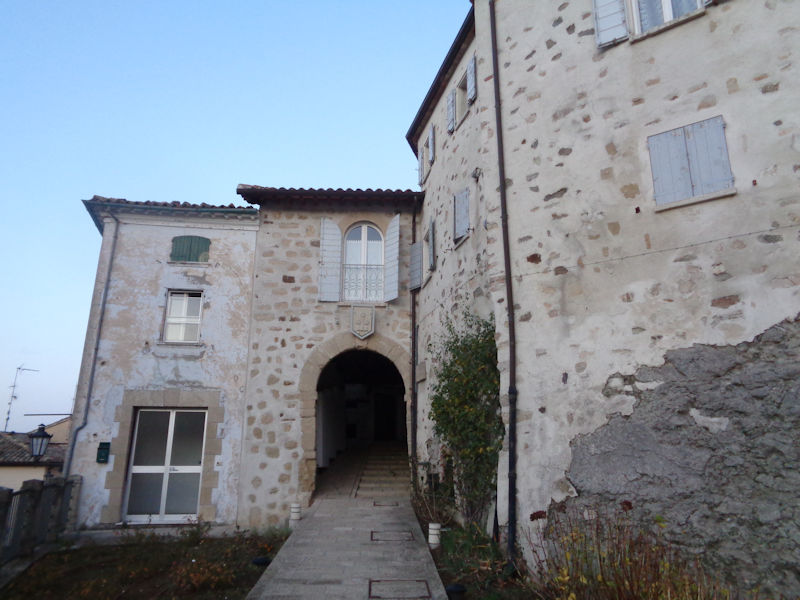
Dusk is approaching and we're leaving soon, so this may be our only opportunity to look into the labyrinthine warren of habitations in the old former castello.

Surely the residents park their cars elsewhere.

And schlep their weekly groceries in by hand


Views inside the castello area of Montegiardino
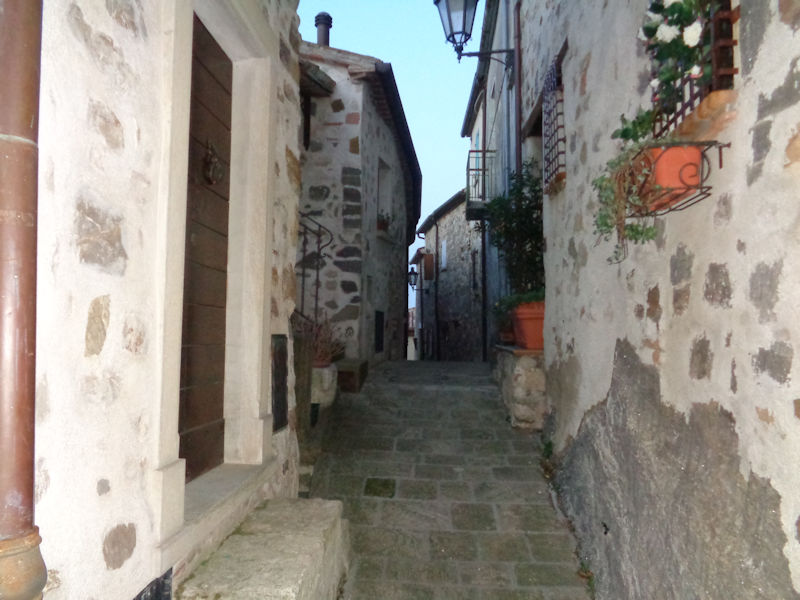
The way out

Descending upon our very own terrasse in the Modà Antica Locanda.
Next: Another go at Rimini

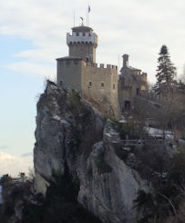 Dwight Peck's personal website
Dwight Peck's personal website







































































